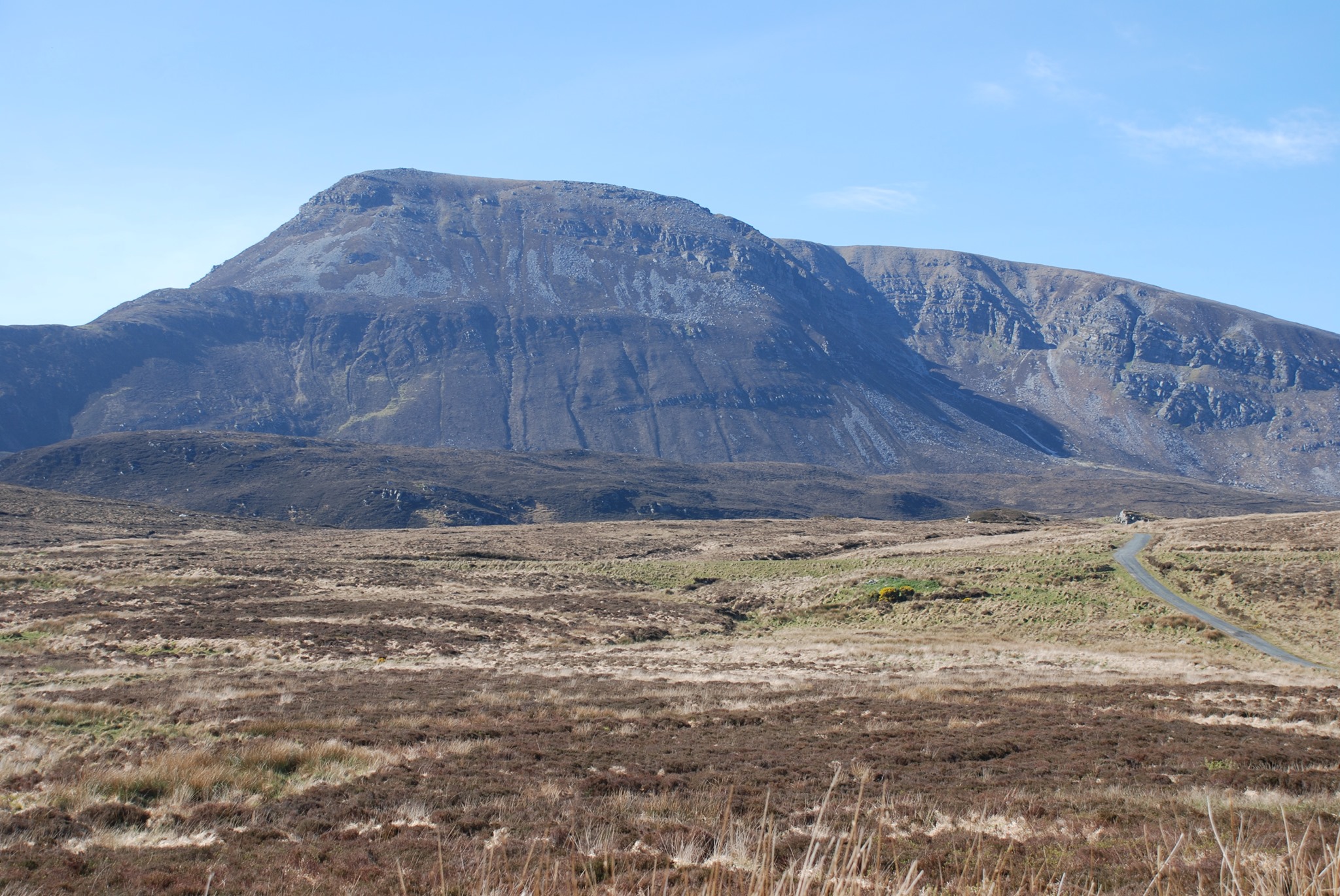Muckish Mountain is widely known for its distinctive flat-topped shape, which inspired its name. Derived from the Irish word “Mucais,” meaning “pig’s back,” the mountain’s striking features include a large cairn visible from miles away and a metal cross on a stone pedestal at its northern end. The southern plateau falls away into a rugged cliff, adding to its dramatic appearance. However, beyond its natural beauty, Muckish Mountain is deeply connected to the history of sand excavation, which played a vital role in local industry and the economy in years gone by.
The Rich Quartz Sands of Muckish
For centuries, Muckish has been known for its high-quality quartz sand. This brilliant white sand, rich in silica, was of exceptional purity, making it ideal for glassmaking. The history of quarrying on Muckish dates back to the early 19th century, when silica sands were manually removed for use in glass production. However, historical records suggest that the sand may have been valued as far back as Roman times, further highlighting its significance.
In 1901, Hugh Law, a local nationalist MP, recognized the potential of the silica deposits and opened the quarry for commercial use. The quartz sand from Muckish gained particular importance during World War II when traditional sources of glassmaking sand, such as those in Belgium, were no longer available. Glass manufacturers, including Pilkington from Lancashire, turned to the high-purity silica sand of Muckish, which was almost 100% pure.
Mining Operations: Life on Glass Mountain
As demand for the quartz sand grew, so did the scale of the mining operation. A pier was constructed at nearby Ards to accommodate the 600-ton sand carriers. Workers, often local men, would set off daily to climb Muckish Mountain, bringing their tools and essentials, including diesel for machinery, dynamite for blasting, and their lunch. They were paid seven shillings a day and faced gruelling work in tough conditions. The ascent took about 30 minutes, and the workers had little rest before starting their long shifts.
Pneumatic drills, jackhammers, and dynamite soon replaced the initial manual labour, increasing productivity. A network of wooden chutes stretched from the quarry to the base of the mountain, where water flushed the sand down to be crushed before being transported to Ards pier for export. The sand was then manually loaded onto ships, often requiring the men to work through the night to meet the tides.
A narrow-gauge railway system was introduced to transport the sand more efficiently down the mountain. Despite wartime shortages, two Ford V8 trucks managed to carry 15 loads of Muckish sand daily. At the pier, the sand was further crushed, screened, and dried before being shipped to glass factories.
The Workers of Muckish
The labour-intensive nature of the work made for a challenging and dangerous life for the quarry workers. Among the men who toiled on “Glass Mountain” were locals like Danny Ward, Tom Doherty, Brian Boyle, and Willie Kelly. They provided firsthand accounts of the harsh conditions. Kelly, for instance, was responsible for transporting workers to the mountain each day, starting his rounds in the morning and picking up workers from different points enroute to Muckish.
The workers often spoke of the tough realities of their job. Bad weather meant sitting in the huts, but no work meant no pay. Incidents like the accidental detonation of explosives during lunch in a tin hut made the work even more precarious. However, camaraderie and resilience helped them endure.
In 1949, the workers’ plight was raised in the Dáil Éireann (the Irish parliament), with calls to extend “wet time” compensation to cover quarry workers. This proposal was ultimately rejected, leaving the men to contend with periods of unpaid downtime due to inclement weather.
The Decline of the Industry
By the early 1950s, glass production in mainland Europe had recovered, reducing the demand for Muckish sand. In 1954, the once-bustling quarrying operations ceased, and the crushers at Muckish fell silent. The wooden chute, once vital to the transport of sand down the mountain, was left to rot, and most of the machinery was removed. What remains today are rusting relics bolted to the mountainside, serving as reminders of the mountain’s industrial past.
There were efforts in the 1960s to revive the industry, with one local developer attempting to restart sand extraction. However, these efforts were short-lived, and the silica sand industry on Muckish became a relic of the past.
The impact of the sand excavation was profound, both economically and environmentally. It provided vital employment to local communities during difficult times, but it also altered the landscape of Muckish. Concerns about environmental degradation contributed to the industry’s decline, and by the late 20th century, the mountain’s role in sand mining had become part of its history.
Today, Muckish Mountain is a popular destination for hikers, offering panoramic views of Donegal and its surrounding areas. Visitors can still see the old railway tracks, decaying wooden chutes, and remnants of machinery, which serve as historical markers of the once-thriving quarry. These “rusting icons,” as they have been called, offer a glimpse into a time when Muckish’s sands were a valued commodity.
For those interested in learning more about the sand excavation, local filmmakers have created a documentary about the quarrying history on Muckish called Glass Mountain. You can watch it below.
Though the sands of time have stilled the once-bustling quarry, the legacy of Muckish Mountain’s role in glassmaking remains etched in the landscape and memory of Donegal.

